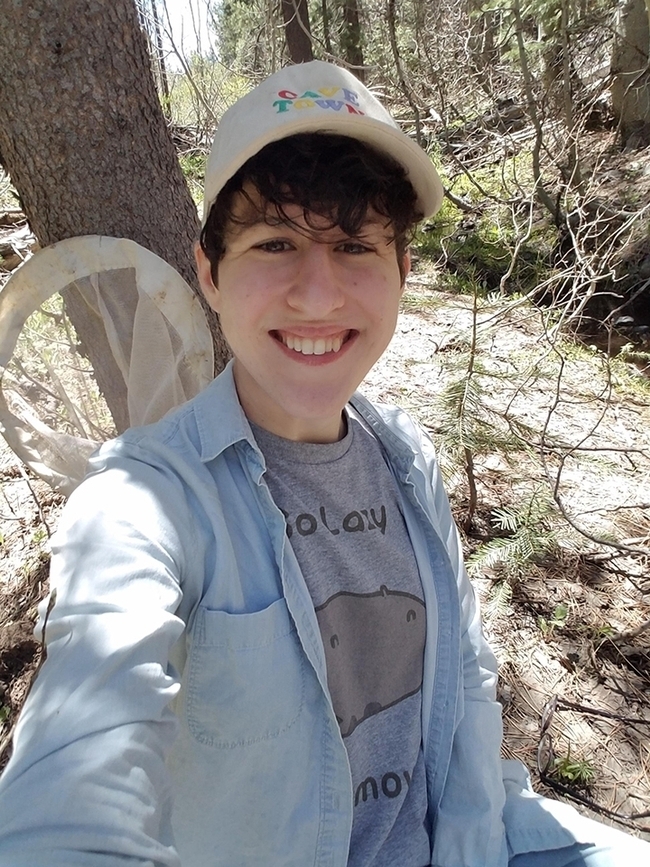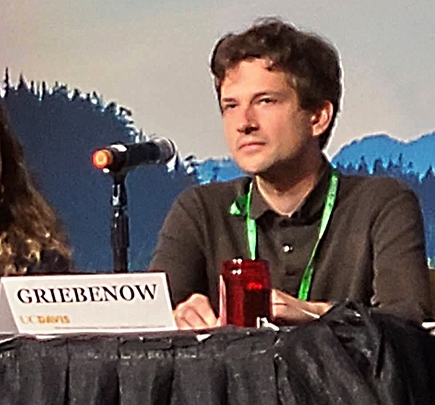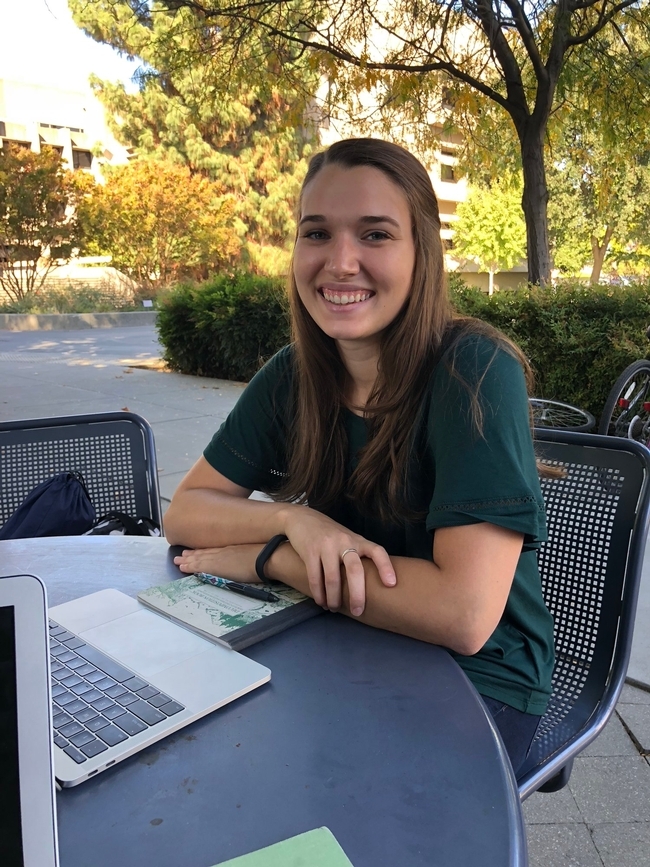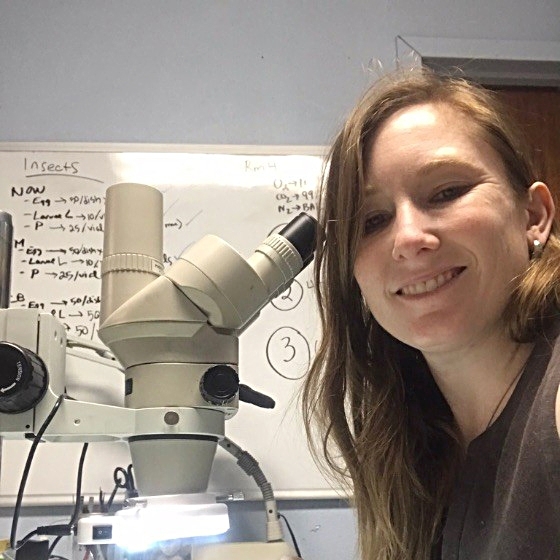
They did UC Davis proud at the annual Entomological Society of America (ESA) meeting, which this year was a Joint Meeting of the Entomological Societies of America, Canada, and British Columbia. It took place Nov. 13-16 in Vancouver, British Columbia.
Doctoral candidates Danielle Rutkowski and Zachary Griebenow won the President's Prize or first-place honors for their individual research presentations. This was Rutkowski's second consecutive President's Prize.
Doctoral candidate Lindsey Mack and doctoral student Adelaine “Addie” Abrams scored runner-up or second-place for their research presentations in the highly competitive program.
Their topics ranged from bumble bees (Rutkowski) and ants (Griebenow) to mosquitoes (Mack) and thrips and aphids (Abrams).
At the ESA annual meetings, students are offered the opportunity to present their research and win prizes. They can compete in 10-minute papers (oral), posters, or infographics. The President's Prize winners receive a one-year paid membership in ESA, a $75 cash prize, and a certificate. Second-winners score a one-year free membership in ESA and a certificate.
Danielle Rutkowski
Danielle Rutkowski, who studies with community ecologists Rachel Vannette, associate professor, and distinguished professor Richard “Rick” Karban, spoke on “The Mechanism Behind Beneficial Effects of Bee-Associated Fungi on Bumble Bee Health,” at her presentation in the category, Graduate School Plant-Insect Ecosytems: Pollinators.
Her abstract: "Bees often interact with fungi, including at flowers and within bee nests. We have previously found that supplementing bumble bee colonies with these bee-associated fungi improves bee survival and increases reproductive output, but the mechanisms behind these effects are unclear. This research aimed to determine the mechanisms underlying positive impacts of fungal supplementation in the bumble bee, Bombus impatiens. We tested two hypotheses regarding possible nutritional benefits provided by bee-associated fungi. These included the role of fungi as a direct food source to bees, and the production of nutritionally important metabolites by fungi. To test these mechanisms, we created microcolonies bumble bees and exposed each microcolony to one of four treatment groups. These four treatments were created based on the presence of fungal cells and the presence of fungal metabolites. We found that bee survival and reproduction were unaffected by treatment, with trends of decreased survival and reproduction when fungi were present. This contradicts previous results we've found using this bumble bee species, where fungi had a positive impact. It is possible that this disparity in results is due to differences in pathogen pressure between the two experiments, as bees in the first experiment were exposed to large amounts of pathogen through provided pollen, including Ascosphaera and Aspergillus. This pollen was sterilized for subsequent experiments, reducing pathogen load. Therefore, it is possible that bee-associated fungi benefit bees through pathogen inhibition, and future work exploring this hypothesis is necessary to fully understand the role of these fungi in bumble bee health."

Zach Griebenow, who studies with major professor and ant specialist Phil Ward, (Griebenow also captained the UC Davis Entomology Games Team in its national championship win at the Entomology Games or Bug Bowl) explained “Systematic Revision of the Obscure Ant Subfamily Leptanillinae (Hymenoptera: Formicidae), Reciprocally Informed by Phylogenomic Inference and Morphological Data.” His category: Graduate School Systematics, Evolution and Biodiversity: Evolution 1.
His abstract: "Ants belonging to the subfamily Leptanillinae (Hymenoptera: Formicidae) are sister to nearly all other extant ants. Miniscule and subterranean, little is known of their behavior. Contrary to the collecting bias observed in most ants, male leptanilline specimens are acquired more easily than workers or queens. The sexes are almost never collected in association, and many subclades within the Leptanillinae are known from male specimens only. Our comprehension of evolutionary relationships among the Leptanillinae is further obstructed by oft-bizarre derivation in male phenotypes that are too disparate for phylogeny to be intuited from morphology alone. These restrictions plague our understanding of the Leptanillinae with probable taxonomic redundancy. My thesis aims at leptanilline taxonomy that reflects phylogeny, inferred from both genotype and phenotype, and integrates morphological data from both sexes. Here I present the results of (1) phylogenomic inference from ultra-conserved elements (UCEs), compensating for potential systematic biases in these data, representing 63 terminals; and (2) Bayesian total-evidence inferences from a handful of loci, jointly with discrete male morphological characters coded in binary non-additive or multistate fashion. Notably, these analyses identify worker specimens belonging to the genera Noonilla and Yavnella, which were heretofore known only from males. Given such discoveries across the Leptanillinae, the number of valid leptanilline genera is reduced from seven to three in order to create a genus-level classification that upholds monophyly along with diagnostic utility."

Mack, who studies with medical entomologist-geneticist Geoffrey Attardo, assistant professor, covered “Three Dimensional Analysis of Vitellogenesis in Aedes aegypi Using Synchrotron X-Ray MicroCT” in the category, Graduate School Physiology, Biochemistry and Toxicology: Physiology.
Her abstract: "Traditional methods of viewing the internal anatomy of insects require some degree of tissue manipulation and/or destruction. Using synchrotron-based x-ray phase contrast microCT (pcMicroCT) avoids this issue and has the capability to produce high contrast, three dimensional images. Our lab is using this technique to study the morphological changes occurring in the mosquito Aedes aegypti during its reproductive cycle. Ae. aegypti is the primary global arbovirus vector, present on all continents except Antarctica. Their ability to spread these viruses is tightly linked with their ability to reproduce, as the production of eggs in this species is initiated by blood feeding. Amazingly, this species produces a full cohort of eggs (typically 50-100) in just 3 days' time following a blood meal. This rapid development represents dramatic shifts in physiological processes that result in massive volumetric changes to internal anatomy over time. To explore these changes thoroughly, a time course of microCT scans were completed over the vitellogenic period. This dataset provides a virtual representation of the volumetric, conformational, and positional changes occurring in tissues important for reproduction across the vitellogenic period. This dataset provides the field of vector biology with a detailed three-dimensional internal atlas of the processes of vitellogenesis in Ae. aegypti."

Abrams, who studies with Extension agricultural entomologist and assistant professor Ian Grettenberger (she is a member of the Horticulture and Agronomy Graduate Group), titled her research, “Hitting the Mark: Precision Pesticide Applications for the Control of Aphids in California Lettuce" in the category, Graduate School Physiology, Biochemistry and Toxicology: Integrated Pest Management.
Her abstract: "Commercial lettuce production in California's central coast represents 70 percent of the production in the United States. Recent discoveries of some chemistries in ground and surface water in the Salinas valley region have placed the insecticidal chemistries used by the industry at risk of increased regulation. Automated thinner-sprayers use plant-detection sensors to apply chemical sprays directly to individual lettuce plants, so that the same amount of product to plants as a standard broadcast sprayer while potentially reducing the amount of pesticide applied per acre by up to 90 percent. Field experiments testing this technology for the control of western flower thrips (Frankliniella occidentalis) and aphids, lettuce-currant aphid (Nasovonia ribisnigri) and others, were conducted to compare the efficacy of automated sprays to a conventional broadcast application system. Experiments were conducted in conventionally managed organic romaine lettuce fields using a complete randomized block design. Prior to and at regular intervals after treatment, heads were sampled from experimental and control plots to assess pest pressure. Results from this experiment validate the use of the automated sprayers to apply insecticides for the control of aphid and thrips pests in lettuce and will be discussed in the context of developing best-use-practices for this technology."
The 7000-member ESA, founded in 1889, is the largest organization in the world serving the professional and scientific needs of entomologists and individuals in related disciplines. Its members, affiliated with educational institutions, health agencies, private industry, and government, are researchers, teachers, extension service personnel, administrators, marketing representatives, research technicians, consultants, students, pest management professionals, and hobbyists.
(See all of student competition winners on ESA site)